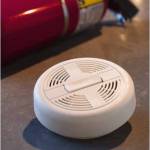10 Nov “It” couldn’t happen to you

Here are three common scenarios we all have done at some point in time: 1) pulled the battery or the wire from the smoke alarm when something set it off – and we didn’t reactivate it. 2) Pulled the battery from the alarm when it reminded us to replace it with that annoying little tweet. 3) Failed to replace an alarm that was more than ten years old. So, what is it that makes us believe “it” isn’t important and couldn’t happen to us?
The “it”, of course, is a fire. The National Fire Protection Association (NFPA) reports that in 2010, public fire departments responded to 1.3 million fires; there were more than 3,000 civilian fire deaths in the United States and more than 17,000 fire-related civilian injuries in that year. Gratefully, the incidence of fire-related deaths is a fraction of the old days when fireplaces, wood stoves, candles and poor construction made home fires far more likely.
Since 1977, the use of home smoke alarms has increased from about 22 percent to about 96 percent according to data on found at freakonomics.com. This source also indicates that the death rate since 1918 from fire and burns has dropped from ten per hundred thousand people to approximately one per one hundred thousand. Better construction, fewer open flames, central heating systems, fewer smokers and public awareness certainly have been contributors to a lower incident rate.
Joe Fleming, a Boston Deputy Fire Chief and the author of the freakonomics.com article notes, however, that deaths due to fire have been relatively flat since the proliferation of ionization alarms. He contends that other factors have brought down the rate and that many deaths are due to confined space fires (e.g. fires that originate in a single room without a photoelectric sensor such as from a smoldering cigarette, incense and resistance heating devices). That is why all the alarms in his home are photoelectric sensors.
Even with improvements, tragedies happen. Sixty percent of home fire deaths occur in homes with no smoke alarms or no working smoke alarms.
In researching this article, I discovered some facts that may help you be more diligent about your household safety. For example, one that I had not considered was the age of the smoke alarm. I recently hit the test button of one of our home alarms after replacing a battery. All I got was a whimpy buzz that was more like a mosquito than a life saving alarm. It then occurred to me that we had been living in our house for more than ten years. Oops – my bad. All alarms now have been replaced with photoelectric/ ionization combination alarms at about $20 each.
- If alarms are more than ten years old, they need to be replaced. The sensors have a life span. The element in the alarm that makes it work degrades over time.
- An alarm should have both photoelectric and ionization sensors. The photoelectric sensor detects smoldering fires such as ones caused by a discarded cigarette or melting electrical wires. These alarms tend to have less false alarms and provide earlier warnings. An ionization sensor alerts you to fast flaming blazes such as grease fires on your stove.
- Newer home alarm systems can either be hard-wired by an electrician or can be set to go off throughout the house via wireless technology providing extra time should there be a real threat.
- Alarms not only should be certified by a testing laboratory such as Underwriters Laboratories (UL), but also should have a convenient reset and hush button to help avoid having batteries removed and never replaced when false alarms occur.
- Maine laws and New Hampshire laws have strict guidance when it comes to fire protection and prevention, including smoke alarms and carbon monoxide detectors. Though short and to the point, the New Hampshire statute is stricter particularly for rental and multi-family structures.
The easiest way to remember to check detectors and change batteries is on daylight savings days, twice a year. Even plug-in or hard wired devices still may need a battery backup.
Also, if you are a renter, be sure to alert your landlord in writing if your smoke and carbon monoxide detectors are not working or have not been serviced. In addition, we suggest you buy renter’s insurance that will help pay for smoke and water damage should a fire occur. Most renter’s policies cover not only your possessions (e.g. repair, replacement and cleaning) but also your cost for housing if you are forced to vacate your apartment.
Though the odds against being injured or dying in a fire are in your favor, why take a chance that “it” couldn’t happen to you?
P.S. Don’t forget to have a fully charged fire extinguisher in your home or apartment.



